Matthew Joseph Ruggirello
Other projects
4 Aug 2021
Wildfire at the End of the World: Sub-Antarctic Beech Trees and their Response to Anthropogenic Fire: Implications for Forest Conservation and Restoration
In phase one of this project, we determined that tree regeneration is inhibited in the interior of burned areas and on severely burned soils. The second phase of this project will include field data collection to create a fire-severity guide, continued monitoring of a restoration experiment, measurement and maintenance of shade tunnel/experimental garden installations, outreach to the broader community of forest users, and a tree-planting event.

A forest that burned in 1978 was heavily grazed post-fire and is now dominated by the local bush, calafate.
Wildfires in Tierra del Fuego, southern Argentina, have had devastating impacts on thousands of hectares of forest: tree regeneration post-fire has been sparse. Post-fire plantings have been done without scientific support. Concern from local governments, private industry, and NGOs active in the region is, however, growing; there is a pressing need to adapt local communities to fire-prone ecosystems and actively restore forests that are not recovering post-wildfire. The forests of Tierra del Fuego are not evolutionarily adapted to wildfire. However, we do not know to what extent these forests might have some inherent resistance and resilience to fire. In the first part of this project, we determined that burned soil inhibits seedling growth and may increase mortality. Severely burned soils have more nitrogen, moisture, and organic material than unburned and lightly burned soils, but a lower pH (more acidic) and less phosphorus. By taking soil samples in the plots established in phase one of this project, we will be able to identify what environmental and post-fire conditions are most commonly associated with severely burned soils properties. This will be the first time ever that fire severity will be systematically analysed in the region. We have already determined that severely burned areas are likely to regenerate tree cover more slowly, if at all. We plan to form emergent conclusions from data already collected and soils to be sampled this field season to create the first ever fire-severity, field identification guide for Tierra del Fuego. Such guides are often region specific and land managers will be able to reference the ones we create to rapidly determine burn severity in the field and focus their restoration planting on the areas of greatest need.